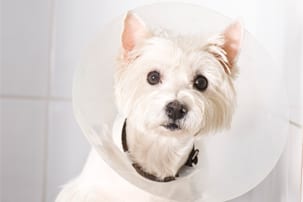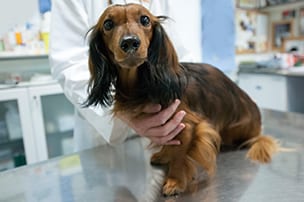
Dog & Cat Surgery at Palos Animal Hospital in Palos Heights
The veterinarians at Palos Animal Hospital are equipped to handle a variety of soft tissue surgeries on dogs and cats. For orthopedic and more complicated surgical procedures, we rely on the services of a traveling veterinary surgeon. Our surgical services align with AAHA Standards of Accreditation, which means we offer the best surgical techniques and sterile practices. We also offer dedicated surgical suites, which are equipped with heated tables for your pet’s comfort, and state-of-the-art monitoring equipment to check your pet’s vitals. All surgical procedures are performed under general anesthesia, for the safety of our patients.
What to Expect Before Dog or Cat Surgery
Before performing any kind of dog or cat surgery, whether it’s soft tissue or dental, we perform a physical exam and pre-anesthetic blood work to ensure that your pet is healthy enough for the planned procedure. An ECG may also be required for older pets or pets with known heart disease. If any health problems are found, we typically treat them first and postpone the surgery. We recommend that your pet not eat later than midnight on the night before surgery and have limited access to water to reduce the risk of vomiting. If you would like any other services performed on the day of surgery, while your pet is under anesthesia (ear cleaning, dental care, microchip implanting, etc.) be sure to let us know, and we can give you a quote.

What to Expect on Surgery Day
When your pet has been cleared for surgery, we set up the monitoring equipment to check your pet’s heart rate and rhythm, temperature, blood pressure, respiration and carbon dioxide level, and blood oxygen level. These vitals are monitored before, during, and after your pet’s surgery. We then place the IV catheter for fluids to maintain hydration and blood pressure. Next, we administer general anesthesia, tailored to your pet’s specific needs, and administer any necessary pain medication. When your pet is under, we shave the area where incisions will be made and sterilize the skin. Then, we begin surgery.

What to Expect After Dog or Cat Surgery
Once your dog or cat’s surgery is complete, we gradually reduce the anesthesia while continuing to monitor your pet’s vitals. When your pet is ready to be released, we contact you and provided printed discharge instructions upon your arrival. Most pets go home with sutures that need to be removed in 10-14 days, so you will need to keep an eye on the surgical site and monitor for swelling, redness, or discharge. Most dogs and cats will leave their incisions alone and not lick or chew at the sutures, but it is an occasional problem you will need to watch for. You will also need to limit your pet’s activity during this time, and no baths are allowed until the sutures are removed. If you have any questions about your pet’s surgery or recovery, please don’t hesitate to call us at 708-448-6600.


